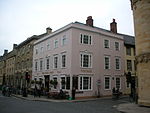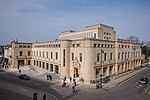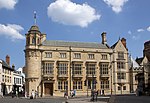Wadham College, Oxford

Wadham College () is one of the constituent colleges of the University of Oxford in the United Kingdom. It is located in the centre of Oxford, at the intersection of Broad Street and Parks Road. Wadham College was founded in 1610 by Dorothy Wadham, according to the will of her late husband Nicholas Wadham, a member of an ancient Devon and Somerset family. The central buildings, a notable example of Jacobean architecture, were designed by the architect William Arnold and erected between 1610 and 1613. They include a large and ornate Hall. Adjacent to the central buildings are the Wadham Gardens. Amongst Wadham's most famous alumni is Sir Christopher Wren. Wren was one of a brilliant group of experimental scientists at Oxford in the 1650s, the Oxford Philosophical Club, which included Robert Boyle and Robert Hooke. This group held regular meetings at Wadham College under the guidance of the warden, John Wilkins, and the group formed the nucleus which went on to found the Royal Society. Wadham is a liberal and progressive college which aims to maintain the diversity of its student body and a friendly atmosphere. Founded as a men's college, in 1974 it was among the first to become coeducational, and the college has a strong reputation as a promoter of gay rights. In 2011 it became the first Oxford college to fly the rainbow flag as part of queer week, a celebration of sexual diversity and individuality.Wadham is one of the largest colleges of the University of Oxford, with about 480 undergraduates and 240 graduate students. The college publishes an annual magazine for alumni, the Wadham College Gazette.As of 2022, it had an estimated financial endowment of £113 million, and in 2020/2021 ranked 18th in the Norrington Table, a measure which ranks Oxford colleges by academic performance.
Excerpt from the Wikipedia article Wadham College, Oxford (License: CC BY-SA 3.0, Authors, Images).Wadham College, Oxford
Holywell Street, Oxford City Centre
Geographical coordinates (GPS) Address External links Nearby Places Show on map
Geographical coordinates (GPS)
| Latitude | Longitude |
|---|---|
| N 51.755871 ° | E -1.254593 ° |
Address
Wadham College
Holywell Street
OX1 3SD Oxford, City Centre
England, United Kingdom
Open on Google Maps






